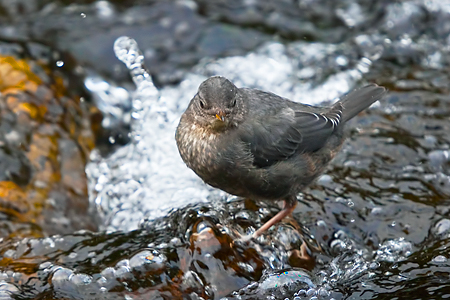
Adaptation
The American Dipper has adapted to its environment in
different ways throughout its existence. It has a soft filmy
plumage with a very thick undercoat of down which helps to keep
the bird well insulated so that it can stay warm during the cold
winters. Another way it deals with the freezing winter
temperatures is by having a low metabolic rate and extra
oxygen-carrying capacity in its blood. The American Dipper’s
preen gland is much larger and more active than other passerine
birds. This gland provides oil to k eep
the birds’ feather waterproof so it can live out its daily life
in the water (Austin 1961). It is because of these adaptions
that the bird is able to hunt year round and withstand such
harsh conditions. The harsh conditions they endure include
extremely cold temperatures of around -45 degrees Celsius.
During this time they feed under places in the ice that aren't completely
frozen over (Perrins 1985). It is said that they are not
bothered by these temperatures and that no canyon is too cold
for them (Muir 2013). Fat storage is essential for the American
Dipper so that it can survive the winter. They build up fat reserves during the transition time of summer to
winter because they know less food and shorter days are soon to
come (Whitehorne 2010). The American Dipper has adapted a
moveable flap covering their nostril to keep
water out of their nose while swimming underwater. They also
needed a structure that was going to help keep water out of
their eyes while being around splashing water. For this purpose they have
a third membrane over their eye called a nictating membrane. The
American Dipper's adpatations have been crucial to its survival
in the aquatic environment where it lives.
eep
the birds’ feather waterproof so it can live out its daily life
in the water (Austin 1961). It is because of these adaptions
that the bird is able to hunt year round and withstand such
harsh conditions. The harsh conditions they endure include
extremely cold temperatures of around -45 degrees Celsius.
During this time they feed under places in the ice that aren't completely
frozen over (Perrins 1985). It is said that they are not
bothered by these temperatures and that no canyon is too cold
for them (Muir 2013). Fat storage is essential for the American
Dipper so that it can survive the winter. They build up fat reserves during the transition time of summer to
winter because they know less food and shorter days are soon to
come (Whitehorne 2010). The American Dipper has adapted a
moveable flap covering their nostril to keep
water out of their nose while swimming underwater. They also
needed a structure that was going to help keep water out of
their eyes while being around splashing water. For this purpose they have
a third membrane over their eye called a nictating membrane. The
American Dipper's adpatations have been crucial to its survival
in the aquatic environment where it lives.